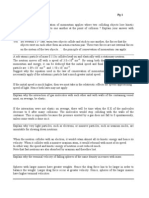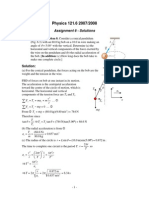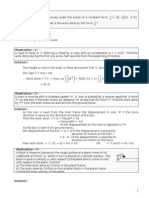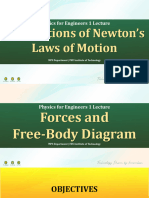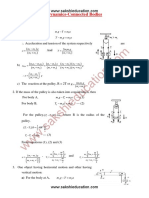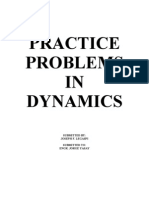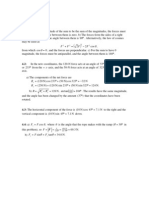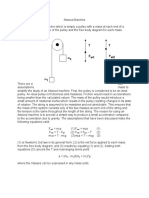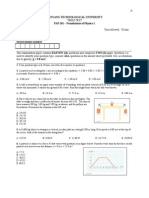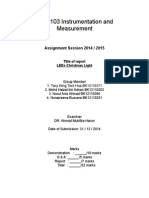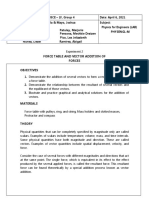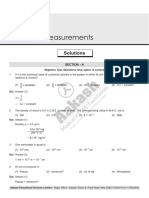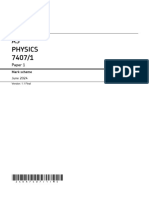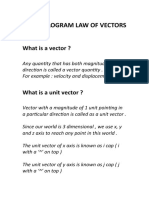Physics 121.6 2007/2008: Assignment 4 - Solutions
Physics 121.6 2007/2008: Assignment 4 - Solutions
Uploaded by
LuwakCoffeenya YHogiCopyright:
Available Formats
Physics 121.6 2007/2008: Assignment 4 - Solutions
Physics 121.6 2007/2008: Assignment 4 - Solutions
Uploaded by
LuwakCoffeenya YHogiOriginal Title
Copyright
Available Formats
Share this document
Did you find this document useful?
Is this content inappropriate?
Copyright:
Available Formats
Physics 121.6 2007/2008: Assignment 4 - Solutions
Physics 121.6 2007/2008: Assignment 4 - Solutions
Uploaded by
LuwakCoffeenya YHogiCopyright:
Available Formats
Physics 121.
6 2007/2008
Assignment 4 - Solutions
1. Chapter 5, Problem 2. A force F
r
applied to an object of mass m
1
produces an
acceleration of 3.00 m/s
2
. The same force applied to a second object of mass m
2
produces an acceleration of 1.00 m/s
2
. (a) What is the value of the ratio m
1
/m
2
?
(b) If m
1
and m
2
are combined into one object, what is the acceleration under the
action of the force F
r
?
Solution:
With F
r
= F ,
1 1
a m F = with a
1
=3.00 m/s
2
and
2 2
a m F = with a
2
=1.00 m/s
2
(a)
From
1
1
a
F
m = and from
2
2
a
F
m =
So:
3
1
m/s 00 . 3
m/s 00 . 1
2
2
1
2
2
1
2
1
= = = =
a
a
a F
a F
m
m
(b)
What is a when ? a m m F ) (
2 1
+ =
Using and the result from (a): m
2
=3m
1
2 2
4
1
1 4
1
1 1 1 2 1 1 1
m/s 750 . 0 ) m/s 00 . 3 (
4 ) 3 ( ) (
= = =
= + = + =
a a
a m a m m a m m a m
- 1 -
Assignment 4 - Solutions
2. Chapter 5, Problem 6. A woman weighs 120 lb. Determine (a) her weight in
Newtons and (b) her mass in kilograms.
Solution:
(a) Using 1 lb =4.448 N
Her weight is: N 534
lb 1
N 4.448
lb 120 =
= W
(b) Assuming she is on the Earth where g =9.80 m/s
2
,
W =mg
kg 5 . 54
m/s 80 . 9
N 534
2
= = =
g
W
m
3. Chapter 5, Problem 14. Three forces acting on an object are given by
( )N
00 . 2
00 . 2
1
j i F + =
r
, ( )N
00 . 3
00 . 5
2
j i F =
r
, and N )
0 . 45 (
3
i F =
r
. The object
experiences an acceleration of magnitude 3.75 m/s
2
. (a) What is the direction of
the acceleration? (b) What is the mass of the object? (c) If the object is initially at
rest, what is its speed after 10.0 s? (d) What are the velocity components of the
object after 10.0 s?
Solution:
(a) Newtons 2
nd
Law:
= + + = a F F F F
r
r r r r
m
3 2 1
So direction of a is in direction of net force.
r
( ) ( ) ( )
N
) 00 . 1 (
) 0 . 42 (
0 . 45
00 . 3
00 . 5
00 . 2
00 . 2
j i
i j i j i F
+ =
+ + + =
r
So direction of acceleration is given by , the angle counter clockwise around
from the +x axis. Then:
=
= = 4 . 181
0 . 42
00 . 1
tan
x
y
F
F
(3
rd
quadrant) =181 to 3 sig. figs.
(b) ma m = =
a F
r
r
N 0 . 42 N) 00 . 1 ( N) 0 . 42 (
2 2 2 2
= + = + =
y x
F F F
r
So kg 2 . 11
m/s 3.75
N 0 . 42
2
= = =
a
m
F
r
(c) t t
i f
a a v v
r r r r
= + = since we know 0 =
i
v
r
. Therefore
f
v
r
is in same direction as a
r
which is in same direction as
F
r
.
So speed = m/s 5 . 37 ) s 0 . 10 )( m/s 75 . 3 (
2
= = = = at v
f f
v
r
(d) m/s 37.5 ) 4 . 181 cos( ) m/s 5 . 37 ( cos = = =
f xf
v v
m/s 0.893 ) 4 . 181 sin( ) m/s 5 . 37 ( sin = = =
f yf
v v
- 2 -
Assignment 4 - Solutions
4. Imagine you are standing on a cardboard box that is only just strong enough to
support your weight. What would happen to it if you tried to jump into the air?
The cardboard box would
(A) collapse.
(B) be unaffected.
(C) spring up as well.
(D) move sideways.
(E) None of these.
Solution:
When you try to jump into the air, you have to accelerate yourself vertically. To do this
your legs act like springs which act like the interaction between your body and the box.
Since there is an upward force on your body, F, giving you the
upward acceleration, there must be an equal an opposite
downward force on the box.
mg
F
a
+y
Considering an FBD of the forces on the body:
ma mg F
ma mg F F
y
+ =
= =
Thus F is greater than your weight.
Therefore the force downward on the box is greater than your
weight, and is therefore greater than the box can support.
Therefore the box will collapse.
Answer A.
- 3 -
Assignment 4 - Solutions
5. Chapter 5, Problem 20. A bag of cement of weight 325 N
hangs from three wires as shown in Figure P5.20. Two of
the wires make angles
1
=60.0 and
2
=25.0 with the
horizontal. Assuming the system is in equilibrium, find the
tensions T
1
, T
2
, and T
3
in the wires.
Solution:
Since the bag of cement is in equilibrium:
N 325
0
3
3
= =
= =
W T
W T F
y
W
2
T
1
T
2
T
3
A
x
y
2
Since the join at point A is in equilibrium:
= = 0 cos cos
1 1 2 2
T T F
x
= + = 0 sin sin
3 2 2 1 1
T T T F
y
From
2
1
1 2
cos
cos
T T =
and inserting into
[ ]
[ ]
2 1 1
3
1
3 2 1 1 1
3 2
2
1
1 1 1
tan cos sin
tan cos sin
sin
cos
cos
sin
+
=
= +
= +
T
T
T T
T T T
[ ]
N 296
) )tan(25.0 cos(60.0 ) sin(60.0
N 325
1
=
+
= T
Then
N 163
) 0 . 25 cos(
) 0 . 60 cos(
296
cos
cos
2
1
1 2
=
= =
T T
So T
1
=296 N, T
2
=163 N, T
3
=325 N.
- 4 -
Assignment 4 - Solutions
6. Chapter 5, Problem 24. Draw a free-body diagram of a block which slides down
a frictionless plane having an inclination of =15.0. The block starts from rest
at the top, and the length of the incline is 2.00 m. Find (a) the acceleration of the
block and (b) its speed when it reaches the bottom of the incline.
Solution:
FBD:
a
n
mg
x
y
Newtons 2
rd
Law:
mg
mg sin
mg cos
= = = ma ma mg F
x x
sin
= = = 0 cos
y y
ma mg n F
(a) So from first equation:
2
2
m/s 54 . 2
) 0 . 15 sin( ) m/s 80 . 9 (
sin
=
=
= g a
(b) ) ( 2
2 2
i f x xi xf
x x a v v + =
v
xi
=0 since block starts from rest, and let x
i
=0, so x
f
=2.00 m
m/s 19 . 3 m) 00 . 2 )( m/s 54 . 2 ( 2 2
2
= = =
f x xf
x a v
- 5 -
Assignment 4 - Solutions
7. Chapter 5, Problem 26. A 5.00-kg object placed on a frictionless, horizontal
table is connected to a cable that passes over a pulley and then is fastened to a
hanging 9.00-kg object, as in Figure P5.24. Draw free-body diagrams of both
objects. Find the acceleration of the two objects and the tension in the string.
[Assume the mass of the cable and the pulley are negligible and the pulley is
frictionless.]
Solution:
Since we can neglect the masses of the
cable and the pulley, and the pulley is
frictionless the tension at both ends of the
cable are the same (magnitude T).
m
1
=5.00 kg
m
2
=9.00 kg
T
T
Let us assume m
2
accelerates downward
with magnitude a. Since the two things are
connected by the cable the acceleration of
m
1
also has magnitude a, but is to the right.
FBD for m
1
:
a m a m T F
x
x 1 1
= = =
m
1
g
T
n
x
y
a
= = = 0
1 1 y y
a m g m n F
FBD for m
2
:
Note that I have chosen a different coordinate system from the one I
chose for the FBD for m
1
. It does not have to be the same for each
FBD. Here I choose +y to be downward, in the same direction as the
expected acceleration.
m
2
g
T
+y
a
= = = a m a m T g m F
y y 2 2 2
Inserting : , into : a m T
1
=
g
m m
m
a
a m m g m
a m a m g m
) (
) (
2 1
2
2 1 2
2 1 2
+
=
+ =
=
So:
2 2
m/s 30 . 6 ) m/s 80 . 9 (
) kg 00 . 9 kg (5.00
kg 00 . 9
=
+
= a
Then: N 5 . 31 ) m/s 30 . 6 )( kg 00 . 5 (
2
1
= = = a m T
- 6 -
Assignment 4 - Solutions
8. Chapter 5, Problem 28. Two objects are connected by a light string that passes
over a frictionless pulley, as in Figure P5.28. Draw free-body diagrams of both
objects. If the incline is frictionless and if m
1
=2.00 kg, m
2
=6.00 kg, and
=55.0, find (a) the accelerations of the objects, (b) the tension in the string,
and (c) the speed of each object 2.00 s after being released from rest.
Solution:
Since we can neglect the masses of the string and the
pulley, and the pulley is frictionless the tension at both
ends of the cable are the same (magnitude T). Let us
assume m
2
accelerates down the incline with magnitude a.
Since the two things are connected by the string the
acceleration of m
1
also has magnitude a upward.
m
2
T
m
1
FBD of m
1
:
= = a m g m T F
y 1 1
a
+y T
m
1
g
FBD of m
2
:
= = a m T g m F
x 2 2
sin
m
2
g
T
x
y
a
n
m
2
g
m
2
gcos
m
2
gsin
= = 0 cos
2
g m n F
y
From : g m a m T
1 1
+ =
Inserting into :
( )
( )
2 1
1 2
1 2 2 1
2 1 1 2
) sin (
sin
) ( sin
m m
g m m
a
g m g m a m m
a m g m a m g m
+
=
= +
= +
(a) So
( )
2 2
m/s 57 . 3 ) m/s 80 . 9 (
kg 00 . 6 kg 00 . 2
) kg 00 . 2 ) 0 . 55 sin( kg 00 . 6 (
=
+
= a
(b) So T N 7 . 26 ) m/s 80 . 9 m/s 57 . 3 )( kg 00 . 2 ( ) (
2 2
1
= + = + = g a m
(c) For m
1
: v m/s 7.14 s) 00 . 2 )( m/s 57 . 3 (
2
= = = + = at t a v
y yi yf
Therefore speed of both masses is 7.14 m/s.
- 7 -
Assignment 4 - Solutions
9. Is it possible to devise a technique to push on a table without the table pushing
back on you?
(A) Yes, if you and the table are out in space.
(B) Yes, if someone else pushes on the table at the same time.
(C) No.
(D) The question is flawed since a table never pushes in the first place.
(E) Yes, but by a technique different than those listed in options A and B.
Solution:
Newtons 3
rd
Law says there is always a reaction force. So the answer is C.
10. A 100 N weight hangs from the ceiling by a vertical rope (assume the mass of the
rope is negligible). Someone then pushes on the weight with a horizontal force to
hold the weight at rest so that the rope is at a bit of an angle with the vertical.
Compared to when the rope was hanging vertically, the tension in the rope is now
(A) increased.
(B) the same.
(C) decreased.
(D) zero.
(E) changed, but we do not have enough information to say if it has increased or
decreased.
Solution:
Initially:
mg
T
So T =mg since it is in equilibrium.
Now:
T
F
mg
T
F
mg
Since the mass is still in equilibrium, the three forces must add together to give zero. It is
clear from the triangle that the magnitude of T must now be greater than mg.
Therefore the answer is A.
- 8 -
You might also like
- Physics 40a Final Exam ReviewDocument4 pagesPhysics 40a Final Exam ReviewRexRu100% (1)
- H2 Physics DynamicDocument22 pagesH2 Physics DynamicTa Minh Trang100% (1)
- Physics 6A Midterm 1 SolutionsDocument7 pagesPhysics 6A Midterm 1 Solutionsgsingh13100% (1)
- Physics 111 Homework Solution #5Document20 pagesPhysics 111 Homework Solution #5jhunNo ratings yet
- Lecture04 P1 2Document22 pagesLecture04 P1 2conghieuhuynhNo ratings yet
- Lesson 6 Example ProblemsDocument9 pagesLesson 6 Example ProblemsOksana MandrykNo ratings yet
- ALP Solutions Friction Physics Eng JEEDocument8 pagesALP Solutions Friction Physics Eng JEEPranavMachingalNo ratings yet
- Home Work 5 - Chapter 5: SolutionsDocument6 pagesHome Work 5 - Chapter 5: SolutionssarahhNo ratings yet
- 2d Dynamics FR KeyDocument8 pages2d Dynamics FR Keyasmaa eNo ratings yet
- NLM JeeDocument30 pagesNLM JeeAnand JoshiNo ratings yet
- Examples - PhysicsDocument8 pagesExamples - Physicslaila1001No ratings yet
- Physics I ForcesDocument10 pagesPhysics I ForcesisellsaniNo ratings yet
- Work Ower EnergyDocument31 pagesWork Ower EnergyOmprakash Dhaka100% (2)
- 2d-Dynamics FR Practice Problems-AnswersDocument12 pages2d-Dynamics FR Practice Problems-AnswersPenny KNo ratings yet
- Jawaban Soal Latihan1mekanikaDocument46 pagesJawaban Soal Latihan1mekanikaAwank AwaluddinNo ratings yet
- (M5-MAIN) Applications of Newton's Laws of MotionDocument104 pages(M5-MAIN) Applications of Newton's Laws of MotionPirasul GTNo ratings yet
- Lecture 18: Drag Forces and Force Examples: Fixed PulleyDocument29 pagesLecture 18: Drag Forces and Force Examples: Fixed PulleyAyam Mas100% (1)
- Exercises - Chapter 02Document12 pagesExercises - Chapter 02Phong ĐâyNo ratings yet
- Of Momentm, Work Is Equated To A Change in Kinetic EnergyDocument4 pagesOf Momentm, Work Is Equated To A Change in Kinetic EnergyAlexNo ratings yet
- Lecture 22Document62 pagesLecture 22adilafzalkhan4264No ratings yet
- Free Falling BodiesDocument8 pagesFree Falling BodiesGeralyn PalambianoNo ratings yet
- Chapter 5 Newton's Laws of MotionDocument13 pagesChapter 5 Newton's Laws of MotionPremNo ratings yet
- B Answers MomentumDocument33 pagesB Answers MomentumRyan TanNo ratings yet
- Chap2-Phy1 SampleProblems PDFDocument17 pagesChap2-Phy1 SampleProblems PDFBrandy TranNo ratings yet
- HW09 - Angular Momentum Conservation and GravitationDocument8 pagesHW09 - Angular Momentum Conservation and GravitationBradley Nartowt100% (1)
- Mobile Problem Statics: PhysicsDocument16 pagesMobile Problem Statics: PhysicsMalvin Roix OrenseNo ratings yet
- First Second EquilibriumDocument11 pagesFirst Second EquilibriumKamran Ali100% (2)
- HCV FrictionDocument37 pagesHCV FrictionP K SinghNo ratings yet
- Home Work 6 SolutionsDocument9 pagesHome Work 6 SolutionssarahhNo ratings yet
- Solution Exam 1 2010 Summer 121Document5 pagesSolution Exam 1 2010 Summer 121mont121No ratings yet
- Physics Final ProblemsDocument17 pagesPhysics Final ProblemsCheldon BigDaddy Banks100% (1)
- 2 Connected BodiesDocument6 pages2 Connected BodiesGerata Suraj0% (1)
- HW03 - ForcesDocument6 pagesHW03 - ForcesBradley NartowtNo ratings yet
- 7 Solutions 2014 With SoundDocument53 pages7 Solutions 2014 With Soundapi-248740887No ratings yet
- 7 Solutions 2014 With MaterialsDocument54 pages7 Solutions 2014 With Materialsapi-248740887No ratings yet
- Dynamics Prob Set (Seph)Document23 pagesDynamics Prob Set (Seph)Rodge BalNo ratings yet
- HW09 - StaticsDocument6 pagesHW09 - StaticsBradley NartowtNo ratings yet
- Friction and Equilibrium ReviewerDocument10 pagesFriction and Equilibrium ReviewergabongabonNo ratings yet
- Chap6 PhysicsDocument23 pagesChap6 PhysicsMadhavi SivanNo ratings yet
- Example Sheet 1 SolutionsDocument5 pagesExample Sheet 1 SolutionsDominic Dela CruzNo ratings yet
- Sections Page Number: List of ContentsDocument13 pagesSections Page Number: List of ContentsezamNo ratings yet
- Chapter 04Document21 pagesChapter 04Jazmani Toledo AguilarNo ratings yet
- Dynamics ReviewerDocument25 pagesDynamics ReviewerJiyu0% (1)
- S S S 3 Fur Maths 2ND Term E-Note 2017Document31 pagesS S S 3 Fur Maths 2ND Term E-Note 2017Gabriel OnalekeNo ratings yet
- Physics 40A - Final Exam Solutions - Summer 2012: Problem 1 (25 Points)Document12 pagesPhysics 40A - Final Exam Solutions - Summer 2012: Problem 1 (25 Points)Mt RushNo ratings yet
- Laws of Motion and FrictionDocument136 pagesLaws of Motion and FrictionPriyankaMishra100% (1)
- Brilliant'S Full Syllabus Test 4: For Our Students Towards Joint Entrance Examination, 2013Document21 pagesBrilliant'S Full Syllabus Test 4: For Our Students Towards Joint Entrance Examination, 2013cshubham23No ratings yet
- Net 1 Net 2 Net w1 Net w2 1 1 2 2Document6 pagesNet 1 Net 2 Net w1 Net w2 1 1 2 2Cylle Jerone BuenviajeNo ratings yet
- Fundamentals of Physics Extended 10th Edition Halliday Solutions Manual 1Document36 pagesFundamentals of Physics Extended 10th Edition Halliday Solutions Manual 1glenmartinbgapmcynoq100% (48)
- HC Verma Solution Class 11 Physics Chapter 6 FrictionDocument37 pagesHC Verma Solution Class 11 Physics Chapter 6 FrictionashaapoulkarNo ratings yet
- PHYS 151 Homework 6Document7 pagesPHYS 151 Homework 6QuinnNgo100% (1)
- Example: Given: A 0.5 KG Ball of Negligible SizeDocument9 pagesExample: Given: A 0.5 KG Ball of Negligible SizegNo ratings yet
- Forces and Newton'S Laws of Motion: ProblemsDocument67 pagesForces and Newton'S Laws of Motion: ProblemsangelicaNo ratings yet
- DC PandeyDocument3 pagesDC PandeyPulkit AgarwalNo ratings yet
- Midterm SolutionDocument4 pagesMidterm SolutionMabel OngNo ratings yet
- Laws of Motion: Introductory Exercise 5.1Document15 pagesLaws of Motion: Introductory Exercise 5.1Ravi VenkatesanNo ratings yet
- Mini Project ReportDocument11 pagesMini Project ReportNurulAnisAhmad100% (1)
- 0625 m20 QP 12 PDFDocument20 pages0625 m20 QP 12 PDFDesire KandawasvikaNo ratings yet
- Final Lab Report 2 DataDocument17 pagesFinal Lab Report 2 Datapeter vanderNo ratings yet
- STPM 2015 Term 1 Trial SMK Sultan Abdul Hamid QuestionsDocument9 pagesSTPM 2015 Term 1 Trial SMK Sultan Abdul Hamid QuestionsSouseiseki ChromeNo ratings yet
- 10-Force and PressureDocument4 pages10-Force and PressureManvik JainNo ratings yet
- Numerical Simulation of Particulate Materials Using Discrete Element ModellingDocument11 pagesNumerical Simulation of Particulate Materials Using Discrete Element ModellingMan Ho LamNo ratings yet
- Angular Momentum: Reading: Chapter 11 (11-7 To 11-12)Document11 pagesAngular Momentum: Reading: Chapter 11 (11-7 To 11-12)Arafat AnikNo ratings yet
- Removal Circuits1Document5 pagesRemoval Circuits1Rudinico Mariano TolentinoNo ratings yet
- Presentation On Intstrumentation & Control Included Topics:-Deflection & Null Type InstrumentsDocument18 pagesPresentation On Intstrumentation & Control Included Topics:-Deflection & Null Type InstrumentsAakash ahujaNo ratings yet
- Machine Methods A Self-Teaching Introduction - M. Adithan, PHD 'I'Document270 pagesMachine Methods A Self-Teaching Introduction - M. Adithan, PHD 'I'ferick23No ratings yet
- Units N MeasurementsDocument30 pagesUnits N Measurementssajal prustyNo ratings yet
- Part - I: Subjective Questions: Projectile MotionDocument5 pagesPart - I: Subjective Questions: Projectile MotionAtul100% (2)
- General Relativity Px436Document133 pagesGeneral Relativity Px436DiegoNo ratings yet
- Ass ElectricDocument9 pagesAss ElectricMonny MOMNo ratings yet
- Finite Element Modelling Ball Screw Feed Drive SystemsDocument4 pagesFinite Element Modelling Ball Screw Feed Drive SystemsnNo ratings yet
- Science 4 Q3 W1 PPT 1Document33 pagesScience 4 Q3 W1 PPT 1april joy macatangayNo ratings yet
- Kinematics of FlowDocument30 pagesKinematics of Flowtuan0% (1)
- Facts at Your Fingertips-201102-Control Valve Position SensorsDocument1 pageFacts at Your Fingertips-201102-Control Valve Position Sensorsonizuka-t2263No ratings yet
- FM 1321 1323 Controllers For Electric Motor and Diesel EngineDocument165 pagesFM 1321 1323 Controllers For Electric Motor and Diesel EngineTasawwur TahirNo ratings yet
- Magnetic Field LEcture NotesDocument16 pagesMagnetic Field LEcture NotesmissMITNo ratings yet
- Magnetic Contactor Overload Relay: HYUNDAI U-SeriesDocument72 pagesMagnetic Contactor Overload Relay: HYUNDAI U-Serieshakera7536No ratings yet
- AQA-7407-1-Final-MS-Jun24-v1.1Document32 pagesAQA-7407-1-Final-MS-Jun24-v1.1xnfcvn7dmkNo ratings yet
- ch8 12eDocument103 pagesch8 12eareej.fatima1298No ratings yet
- Basic: M1736N Model: MW73VR Model Code: Mw73Vr/BwtDocument42 pagesBasic: M1736N Model: MW73VR Model Code: Mw73Vr/Bwtsantiago962No ratings yet
- 1936-Resistance of Solid Surfaces To Wetting by WaterDocument7 pages1936-Resistance of Solid Surfaces To Wetting by WaterRatanNo ratings yet
- Construction Working Operation and Maintenance of Electrostatic PrecipitatoDocument91 pagesConstruction Working Operation and Maintenance of Electrostatic PrecipitatoWill KisekiNo ratings yet
- Heat Cycling Test Sets For Power Cables: Application DescriptionDocument2 pagesHeat Cycling Test Sets For Power Cables: Application DescriptionkmiqdNo ratings yet
- Parallelogram Law of VectorsDocument7 pagesParallelogram Law of VectorsdeezNo ratings yet
- Smith ChartDocument41 pagesSmith ChartLalit GoelNo ratings yet
- Acceleration LabDocument7 pagesAcceleration Labapi-261954479No ratings yet

